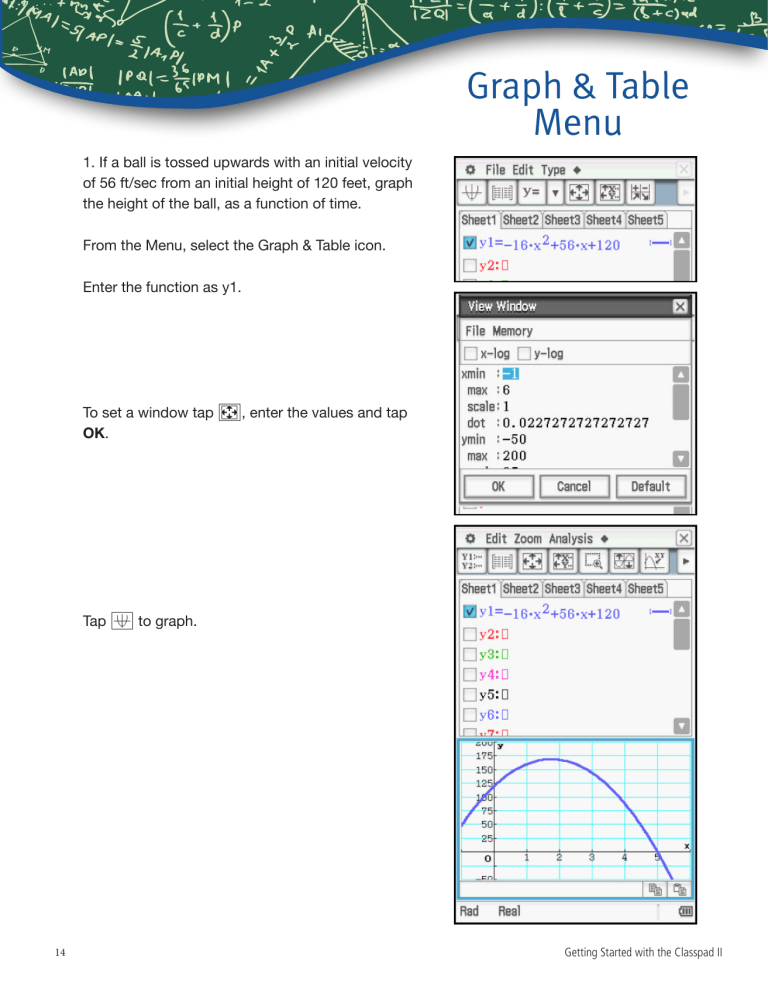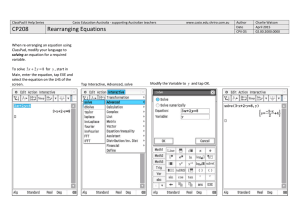
Graph & Table
Menu
1. If a ball is tossed upwards with an initial velocity
of 56 ft/sec from an initial height of 120 feet, graph
the height of the ball, as a function of time.
From the Menu, select the Graph & Table icon.
Enter the function as y1.
To set a window tap 6, enter the values and tap
OK.
Tap $ to graph.
14
Getting Started with the Classpad II
Graph & Table
Menu
Tap r to plot the graph in a full screen. To adjust
the window, use#"23 to scroll in any of
the four directions, + to zoom in, and to zoom out.
2. Compute the height of the ball at time 4 seconds.
To trace, tap =. To find a specific value, press any
one of the number keys; this will open a dialogue
box. Then tap OK.
Getting Started with the Classpad II
15
Graph & Table
Menu
Press E to mark the point and keep the
coordinates on the display.
16
Getting Started with the Classpad II
Graph & Table
Menu
3. Compute the times when the ball is at height
150 feet.
Tap Analysis, G-Solve, x-Cal/y-Cal, x-Cal.
Enter the value for y and tap OK.
Getting Started with the Classpad II
17
Graph & Table
Menu
Press E to mark the point and keep the coordinates on the display.
Press 3 to move to the second point.
4. Compute the time when the ball hits the
ground.
To compute an x-intercept, tap the 3 icon at the
top of the screen, then tap Y.
18
Getting Started with the Classpad II
Graph & Table
Menu
5. Compute the coordinates of the maximum point.
For a maximum point, tap the 3 icon at the top of
the screen, then tap U.
6. Construct a table of values for times
{0, 1, 2, 3, 4, 5}.
To set the table, tap 8.
Enter the values and tap OK.
Getting Started with the Classpad II
19
Graph & Table
Menu
To view the table, tap #.
20
Getting Started with the Classpad II
Graph & Table
Menu
These examples have used the coefficient of -16 for the t2 term. The value of that coefficient
could be different, based on conditions such as altitude. It would also be different on the
moon or another planet, and of course, if different units for distance and/or time were used.
1
A more general equation for the model would be h = − 2 gt2 + vt + c. This is an application of
the general quadratic y = ax2 + bx + c.
7. Explore the transformations of the graph of the
function y = ax2 + bx + c as the coefficients a, b, c
are changed.
Enter the function y1 = 1x2 + 0x + 0. The three
coefficients are needed, as explained later.
Set the window to Default.
Graph the equation.
Getting Started with the Classpad II
21
Graph & Table
Menu
Tap Analysis, Modify.
Enter 1 for the Step size and tap OK.
The word Modify appears on the graph screen,
the graph is thicker, and the function rule appears
in a dialogue box at the bottom. To explore the
transformations, tap any one of the 3 coefficients
and highlight it. Tap on the graph screen. Now use
3 and 2 to increase or decrease the coefficient,
respectively, and see the graph transform.
22
Getting Started with the Classpad II
Graph & Table
Menu
Alternately, to make changes without a step size, tap
any one of the 3 coefficients, highlight it, enter a new
value and press E.
Getting Started with the Classpad II
23



